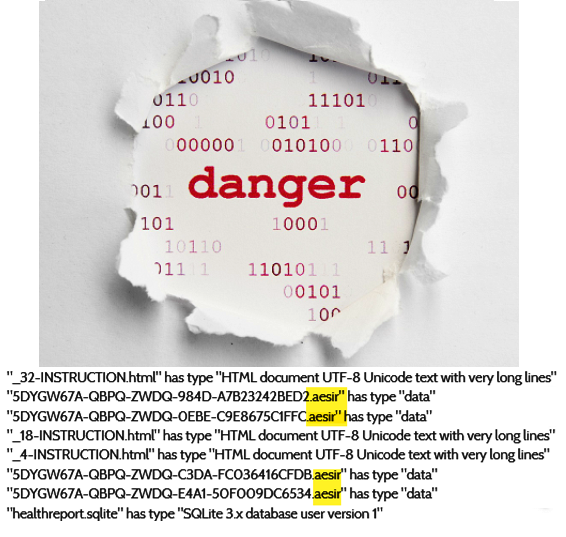The latest variant of the nasty Locky file-encrypting pest has changed its name again. It is now called Aesir because it changes its victims files extensions to .aesir. It leverages an old school trick to proliferate.

Its new version dupes users into enabling macros in a Microsoft Word document delivered over email. Such computer threats as the Dridex banking Trojan have been heavily exploiting the same security loophole for many months.
This distribution tactic engages a botnet to spawn a big amount of spam in one hit. Once a rogue email like that hits a potential victim’s inbox, the user may fail to see it for what it is. That’s because the message will typically address the recipient by name, moreover, it looks like a commonplace invoice.
The attached Word file, when opened, says it is a protected document and displays a security warning. The alert prompts the unsuspecting person to enable content, which translates to turning macros on. This being done, a PowerShell command will run a predefined encrypted string and decrypt it. Consequently, Aesir executable ends up in AppData folder and is launched from there.
The ransomware then scours the plagued machine and network shares for personal data. At the next phase of the attack, it scrambles these files using a strong cryptosystem and creates ransom notes called _[number]-INSTRUCTION.html. This application instructs the victim to visit the Aesir Decryptor page and get payment details to submit the ransom. The size thereof 1 Bitcoin. If it isn’t paid during 5 days, the amount doubles.
Aesir is one of the ransomware samples that cannot be decrypted for free, because the crypto implementation is professional and has no weaknesses. Therefore, users should maintain data backups and steer clear of email attachments that arouse suspicion.
Automatic removal of Aesir ransomware
The benefits of using the automatic security suite to get rid of this infection are obvious: it scans the entire system and detects all potential fragments of the virus, so you are a few mouse clicks away from a complete fix.
- Download and install recommended malware security suite
- Select Start Computer Scan feature and wait until the utility comes up with the scan report. Proceed by clicking on the Fix Threats button, which will trigger a thorough removal process to address all the malware issues compromising your computer and your privacy.
Restore files locked by Aesir ransomware
Aesir represents a unique category of malicious software whose attack surface reaches beyond the operating system and its components, which is why removing the virus itself is a part of the fix only. As it has been mentioned, it encrypts one’s personal information, so the next phase of the overall remediation presupposes reinstating the files that will otherwise remain inaccessible.
-
Launch data recovery software
Similarly to the rest of its fellow-infections, Aesir most likely follows an operational algorithm where it erases the original versions of the victim’s files and actually encrypts their copies. This peculiarity might make your day, because forensics-focused applications like Data Recovery Pro are capable of restoring the information that has been removed. As the virus further evolves, its modus operandi may be altered – in the meanwhile, go ahead and try this.
-
Take advantage of Volume Shadow Copy Service
This technique is based on using the native backup functionality that’s shipped with Windows operating system. Also referred to as Volume Snapshot Service (VSS), this feature makes regular backups of the user’s files and keeps their most recent versions as long as System Restore is on. Aesir virus hasn’t been found to affect these copies therefore the restoration vector in question is strongly recommended. The two sub-sections below highlight the automatic and manual workflow.
- a) Use Shadow Explorer
Shadow Explorer is an applet that provides an easy way of retrieving previous versions of files and folders. Its pro’s include an intuitive interface where the computer’s entire file hierarchy is displayed within one window. Just pick the hard disk volume, select the object or directory to be restored, right-click on it and choose Export. Follow the app’s prompts to get the job done.

- b) Use file properties
Essentially, what the above-mentioned Shadow Explorer tool does is it automates the process that can otherwise be performed manually via the Properties dialog for individual files. This particular approach is more cumbrous but just as effective as its software-based counterpart, so you can proceed by right-clicking on a specific file, which has been encrypted by Aesir ransomware, and selecting Properties in the context menu. The tab named Previous Versions is the next thing to click – it displays available versions of the file by date of the snapshot creation. Pick the latest copy and complete the retrieval by following the prompts.

-
Data backups work wonders
Ransomware like Aesir isn’t nearly as almighty and destructive in case you run regular file backups to the cloud or external data media. The virus itself can be completely removed in a matter of minutes, and the distorted information can then be just as easily recovered from the backup. Luckily, this is a growing trend, so ransom Trojans are hopefully going to become less subversive in the near future.
Verify thoroughness of the removal
Having carried out the instructions above, add a finishing touch to the security procedure by running an additional computer scan to check for residual malware activity
